University referencing guide for beginners
Are you preparing for assignments? Don’t have an idea how to make proper referencing and how to make citations. We introduce a University Referencing Guide for Beginners who enrolled in higher studies and who are not aware with referencing and citations and want to know how to make referencing/citations properly in university assignments. This university guide will help you to make proper understanding of university referencing, citations and you will not feel troubled in assignments referencing whether its any styles of types of referencing or citations. This guide provides you help to understand different types of referencing styles and how to use it in assignments.
Also read:- Importance of referencing in writing an Assignment
Also read:- How Do You Cite Sources?
Why referencing is important in academic work or assignments?
Referencing is very-much important for any type of work or assignments. By giving referencing your work will be more attractive to one who is going through it. Through referencing you are allowed to acknowledge the contribution of various writers and researchers in your projects or any kind of presentation you have to prepare. Doing this means that you are giving credits to the writers and the researchers for the work they had done so clearly. By this your project becomes more valuable or any type of work as so many ideas and that to of different-different peoples who had researched for a long period of time for collecting this much information and useful to. Weas a student should give them appreciation by adding their ideas in our project and making your own work countable. Referencing is also playing a crucial role because it makes your writings more appreciated. By giving referencing it makes the other's clear that whom idea you have taken and from where you have taken that idea. One important point is that reference you are giving should be true, no false accusations on anything you are writing about. Suppose, you are writing about any topic so, in that if you give references then it will make other more understandable that you are very-much cleared about the topic you have chosen.
Also read:- How to avoid plagiarism in Academic Work?
Even this kind of things help you embed your interest more about finding about that topic in depth. Citations also make your own writing more persuasive.
Important factors you need to include while referencing:
The full information about the person, the publications should be there when you are taking reference of any topic, because it makes everyone cleared that whom research you have gone through nd your ideas about that topic.
- Author's name should be given
- Name and location of publishers and their company
- Name of the book or any site link you have gone through
- Name of the chapter that matches your research material
Also read:- Assignment DO’S AND DON’TS
You should mention all the references at the end of the topic. One important point that you should have to give any type of reference on the work, assignments or any kind of experiments that you have performed yourself with your own research or your own observations.
Purpose or the reason of referencing is:
Referencing is the important part of the academic work for academic excellence. By adding references, the authenticity of any kind of work done by student increases and you also feel good that the work you had done full dedication has paid a lot because the appreciation you will get at the end and with a positive news too. By the help of referencing, you are also helping readers as it will help them find that work from which you have written and read them properly and then understand that idea by themselves and as they want to understand.
When you need to use reference:
We use a lot of words and ideas in our resource from others search. What references we have to give when you are using references from any other:
- Books, Journal articles
- Newspaper and any magazine
- Television and radio
- Pamphlets
- Any kind of website
- Personal interviews of that person whom you think is capable
- By letters, post, emails
- Listening to any kind of or any persons
Also read:- What Are Common Mistakes In Referencing Academic Work?
When you give references in your project or any type of academic work it makes everyone clear that from the ideas mentioned in it which are yours and which are not. By doing this we can concatenate views of lots of people in one assignment and of course the knowledge level of that person increases and sometimes develop interest of the specific person in that topic. References always written at the end of the page, so that by the end of your assignment you can give all information with the link so that the reader can read more about the topic if he/she wants with the help of that given reference link.
While giving references everything should be mentioned that we have discussed earlier with the name of author, if author name not known than we mention the title of that reference first and then give the link. The references are separated from one another with the help of commas. We are writing reference to our work to make it the validate one by using any other person's research and if in any case we have to clear all the arguments then one can go through that reference and make itself clear. If we are writing on any topic that is debate full then we use reference to make reader more satisfied that I am agree or disagree with the statement. It puts your work in context, demonstrates the breadth and depth of your research, and acknowledges other people's work. So, by this article you are cleared that reference makes the project more authentic and clearer because it makes the reader more clear and more satisfactory project. By this you will give credits to the author or writer and the researcher because they have spent a lot of time collecting information with true aspects and make all the students helpful with their tasks and completing it.
Also read:- Most common problems faced by student when writing assignments
Here is example of citation using the Lee Harvard style:
- The main considerations are "the scope of the project, the cost and the duration of the work"
(Harris,2001, p.20)
So, in the end we all are aware that we should use references while doing any type of assignments or any type of work. As it makes our work more powerful because we add the creative ideas of more peoples and our own ideas too. Makes the reader clear about the project status and help them by giving references that they can collect more information's through these links. This also enhances our skills of making project, adding on new ideas and making a vast increase in our own knowledge, so that we also become aware of that topic and by these references the reader also thinks that this student is very well knowledgeable about the topic.
It's mandatory to ALWAYS reference your sources, and students have to aware that plagiarism is a SERIOUS OFFENCE that could get you academically excluded, so stay far away from it.
An in-text citation is the reference that is used when you quote something or someone in the body of work such as an essay. The reference list or bibliography is the full citation with all the source's details that goes at the end of the body of work.
Here are some of the main referencing styles we have listed for you which are used in universities and their in-text and explained reference list citation formats of books, websites and journals:
You can hire Expertsminds for best referencing assignment help and they provide you best quality references and citations in your assignment which demands your university.
I am new with referencing, or citation, I want to know how to make referencing or citation – quotes in my university assignment? You search ends here...
1. The Harvard method
Use of The Harvard method referencing in For books:
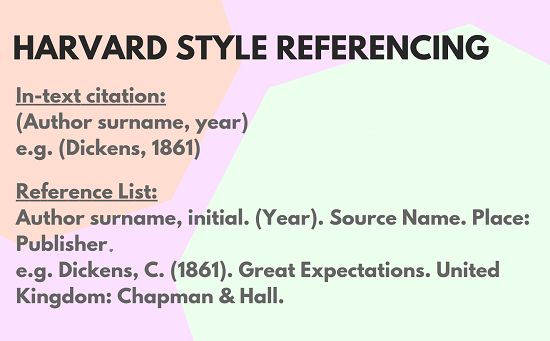
Use of The Harvard method referencing For websites:
In-text citation:
(The author(s) and date created)
Reference list:
Author(s) surname, initial. (Date of publication). Website Title. Available at: https:// link (Access date: date accessed).
Use of The Harvard method referencing For journals:
In-text citation:
(The author(s) and date published)
Reference list:
Author(s), initials. (Year of publication). 'Article title' Journal title Volume of journal, issue number of journal. Page range of article.
Harvard Reference guide -
https://www.expertsminds.com/references/Harvard-Referencing-Guide.pdf
2. APA Style Referencing
American Psychological Association (APA).
Use of APA Style Referencing For books:
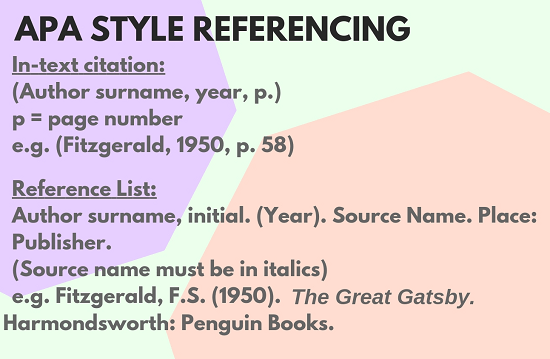
Use of APA Style Referencing For websites:
In-text citation:
(Author surname, year, p.)
p= page number
Reference list:
Author(s) surnames, initials. (Year Month Date published). Article Title. Retrieved from URL.
Use of APA Style Referencing For journals:
In-text citation:
(Author surname, year, p.)
Reference List
Author(s), year of publication, Article Title, Journal Name, volume number, issue number, page number range of the article.
Comparison between APA 6th Edition vs APA 7th Edition:-
https://www.expertsminds.com/references/APA_6th_vs_7th_edition_referencing_Style.pdf
APA Style: Sixth vs. Seventh Edition Referencing comparison and style
Know some Writing and Grammar / Mechanics of Style
|
APA 6th Edition (2010)
|
APA 7th edition(2019)
|
|
Two spaces after punctuation marks in drafts (Section 4.01, p. 88)
|
Single space after all punctuation (Section 6. 1, p. 154)
|
|
Pronouns: "He or she," or plural "they" (Section 3.20, p. 79)
|
Singular "they" is acceptable (Section 4.18, p. 120)
|
|
Editorial "we": No specific guideline
|
Editorial "we" is not permitted (Section 4.17, p. 120)
|
|
Spelling:
|
Spelling:
(Section 6.11, p. 161-162)
|
|
Capitalize nouns followed by numerals or letters, except common parts of books, sections, tables, page (p. or pp.) and paragraph (para. or paras.) (Section 4.17, p. 103)
|
Capitalize all nouns followed by numerals or letters, except page (p. or pp.) and paragraph (para. or paras.). Section is now capitalized (Section) (Section 6.19, p. 168)
|
|
Use numerals to express units of time except when time is an approximation (Section 4.31, pp. 111-112)
|
Use numerals to express all units of time, including approximations (Section 6.32, p. 178)
|
|
No guideline
|
Abbreviate hour, minute, second, millisecond, etc., when followed by a numeric value (Section 6.28, p. 176)
|
|
Use double quotation marks to introduce invented terms or text used ironically, to set off titles in text, and to denote quotes (Section 4.07, pp.91-92)
|
Use of double quotation marks has been expanded to include copyright attribution (Section 6.7, p. 158)
|
|
No guideline
|
Within figure images, use a sans serif font (e.g., Calibri, Arial) with a type size between 8 and 1 points (Section 2.19, p. 44)
|
|
No guideline
|
For computer code, use a monospace Font (e.g., Courier New, Lucida Console) (Section 2.19, p. 44)
|
|
No guideline
|
Footnotes in a page Footer use the wordprocessing program default (Section 2.19, p. 44)
|
|
Citing Material
|
|
|
Use "Author et al." when citing work by six or more authors (Table 6.1, p. 177)
|
Use "Author et al." when citing work by three or more authors (Table 8.1, p. 266)
|
|
References by the same author and publication date are arranged alphabetically by title unless they are part of a series. Use lowercase letters after the year (Section 6.21, p. 182)
|
References by the same author with the same publication date include a lowercase letter after the year and are organized by year-letter (Section 8.19, p. 267)
|
APA Style: Sixth vs. Seventh Edition Reference Entries
|
APA 6th Edition (2010)
|
APA 7th edition(2019)
|
|
Reference Entries
|
|
|
In works with more than seven authors, include the first six plus the last one (p. 198, Example 2)
|
Include up to 20 authors. For 21 authors and more, list the first 19 plus the last one (Section 9.8, p. 286)
|
|
For multiple group authors, list all agencies from largest to smallest as the author (Section 7.03, p. 205, Example 31)
|
For multiple group authors, use the most specific agency as the author (Section 9.11, p. 288)
|
|
Titles of books, journals, magazines, newspapers, and stand-alone publications are set in italics (Section 4.21, p. 104)
|
Italicization has been expanded to include titles of webpages (Section 6.22, pp. 170-171)
|
|
Do not italicize titles of blog posts, online Forum messages, status updates, etc. (APA Style Guide To Electronic References, p. 32)
|
Italicize titles of social media content, online Forum posts, and webpages (Sections. 10.15-10.16, pp. 348-352)
|
|
No guideline
|
New reference categories: webpage on a news website and webpage on a website (Section 10.16, pp. 350-352)
|
|
Include a publication's issue number only when the publication is paginated by issue (Section 6.30, p. 186)
|
Always include a publication's issue number (Section 9.25, p. 294)
|
|
For sources from journals, use the DOI if it has been assigned one. If not, use "Retrieved from" and the exact URL for online sources, or the URL for the journal home page for sources accessed through a database (Section 6.32, pp. 189-192, and Section 7.01, p. 198)
|
For sources from journals, magazines, newspapers, and blogs, finish the reference entry with a DOI or URL as applicable. "Retrieved from" is no longer in use. For database sources, the page range is the last item of the entry (Section 9.25, p. 294)
|
|
No guideline
|
DOIs and URLs are presented as live links (Section 9.35, p. 299)
|
|
FormatDOIsinreference entries as doi:xxx, https://dx.doi.org/xxx, or https://doi.org/xxx
|
The only accepted format for DOIs in reference entries is https://doi.org/xxx (Section 9.35, p. 299)
|
|
No guideline
|
Long DOIs and URLs can be shortened (Section 9.36, p. 300)
|
|
No guideline
|
Include article numbers as "Article xxxx" (Section 9.27, p. 294)
|
|
For books and reports give the publisher's location (Section 6.30, pp. 186-187)
|
Publisher's location is no longer in use (Section 9.29, p. 295)
|
|
|
|
3. MLA Style Referencing
Modern Language Association (MLA)
MLA Style Referencing For books:
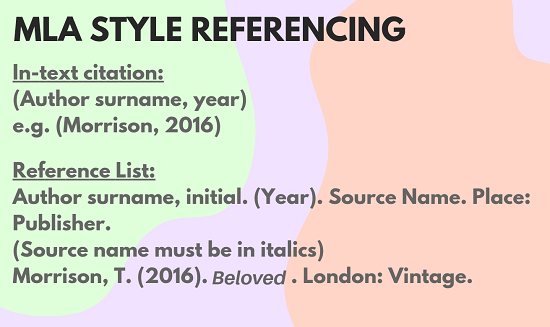
MLA Style Referencing For websites:
In-text citation:
("Title of page" Year published)
Reference List:
Author's Last name, First name. "Title of the Article or Page." Title of the Website, Name of the Publisher, Date of Publication in DD/MM/YYYY format, URL.
MLA Style Referencing For journals:
In-text citation:
(Author surname and page range)
Reference List:
Authors Last name, first name. "Article Title." Journal Title Series Volume. Issue (Year Published): Page(s). Print.
4. Chicago Style Referencing
Chicago Style Referencing For books:
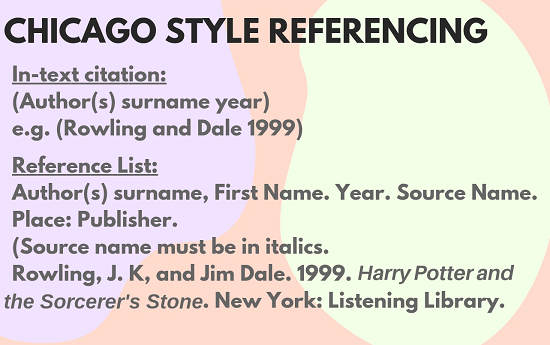
Chicago Style Referencing For websites:
In-text citations:
(Author surname and Year Published)
Reference List:
Author surname, first name. Year. "Page Title" Website Name. URL
Chicago Style Referencing For journals:
In-text citations:
(Author surname and year published)
Reference List:
Author surname, first name. Year. "Article Title". Journal Name volume (issue no.): pages used.
5. AMA Style Referencing
American Medical Association (AMA)
For books:
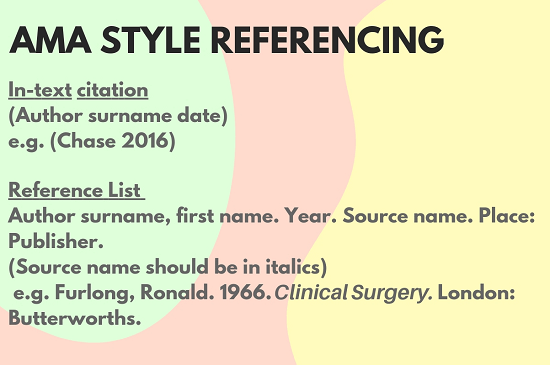
AMA Style Referencing For websites:
In-text citation:
(Author surname and date)
Reference List:
Author surname First name initial. Page Title. Website Name. URL. Published Year. Accessed date.
AMA Style Referencing For journals:
In-text citation:
(Author surname and date)
Reference List:
Author surname First name initial. Journal name. Year of publication: volume number, issue number, page numbers.
6. IEEE Style Referencing and Format
IEEE Referencing includes the all sources of information, such as or borrowed ideas, quotes must be acknowledged in your writing. In the IEEE referencing style, a number [X] is inserted at the point in your writing where you cite another author's work. At the end of your work, the full reference [X] of the work is provided. Citations and their corresponding references are provided in the order they appear throughout your writing.
Citing sources in the text in IEEE referencing format
IEEE in-text citations consist of numbers given in square brackets, which correspond to the appropriate sources in the reference list at the end of the paper.
The in-text citations numbers start at [1] and continue in ascending order throughout the paper - unless you are referring to a source you have already cited in your text, in which case you can use the previously assigned number.
Each in-text citation number should be enclosed by square brackets and appear on the text line, inside sentence punctuation, with a space before the bracket, e.g.
Thevenin's and Norton's theorems are widely used for circuit analysis simplification [13].
Citations of references may be given simply as "in [1]...", rather than as "in reference [1] ...".
Furthermore, citations may be grammatically treated either as if they were:
footnote numbers, e.g.
As shown by Jones [4] [5] ...
For more details, see [1], [3], [7].
as mentioned earlier [3], [4]-[6], [8] ...
Taylor et al. [5] have noted ...
The Reference List in IEEE
A numbered list of references in IEEE referencing may be given at the end of the writing. The reference list in IEEE keeps all the details of all sources cited in-text. Reference list entries should be shown in the order the sources are cited in the text of the paper, beginning with [1], and continuing in the ascending numerical order, from the lowest number to the highest. Reference list entries do not require following an alphabetical order by author or title of sources.
Typical IEEE reference list entry
The typical components of a IEEE reference list are provided below. Each IEEE reference entry should usually contain the referencing elements in the given order (if one of these elements is not matched in the original source, then one can only follow the elements given - do not make others up):
- Citation number, which are enclosed within square brackets, also its aligned along the left margin. The text of the entry is indented 2 or 3 spaces;
- Author(s) name(s): first names' initials are placed first, followed by last names;
- Title of the article, book chapter, conference paper or report is typed in double quotation marks, with text provided in lower case;
- Book , Journal or Conference Title is typed in italics. Capitalize the first letter of each important word in the title;
- Publication information: City, State (if U.S.) or Country if City is not well known: Publisher Name, Date;
- Page number(s) if applicable, i.e. if you are referencing a book section, a book chapter in an edited book, or an article. Page numbers are cited as p. for a single page or pp. for multiple pages.
Comlpete guide for IEEE style and referencing
https://www.expertsminds.com/references//IEEE_format_and_referencing.pdf
IEEE Sample Reference List
-Reference List
[1] R. E. Ziemer and W. H. Tranter, Principles of Communications, 7th ed. Hoboken, NJ: Wiley, 2015. [Online]. Available: https://ebookcentral.proquest.com/lib/vu/reader.cation?docID=5106516&ppg=1
[2] C. Jacks, High Rupturing Capacity (HRC) Fuses. New York: Penguin Random House, 2013, pp. 175–225.
[3] J. D. Bellamy et al., Computer Telephony Integration. New York: Wiley, 2010.
[4] N. B. Vargafik, J. A. Wiebelt, and J. F. Malloy, "Radiative transfer," in Convective Heat. Melbourne: Engineering Education Australia, 2011, ch. 9, pp. 379–398.
[5] W. M. Rohsenow, "Heat transmission," in Thermal Radiation Properties, vol. 3, M. W. Catton and J. P. Hartnett, Eds. New York: Macmillan, 2012, ch. 9, pp. 37–62.
[6] H. C. Hottel and R. Siegel, "Film condensation," in Handbook of Heat Transfer, 2nd ed. W. C. McAdams, Ed. New York: McGraw-Hill, 2011, ch. 9, pp. 78–99.